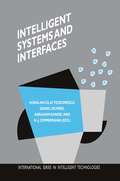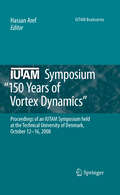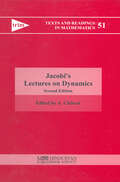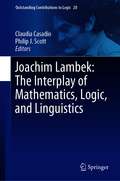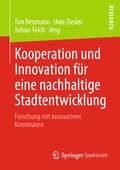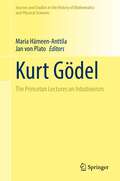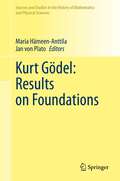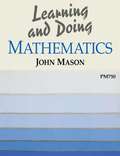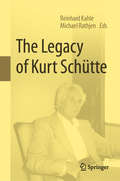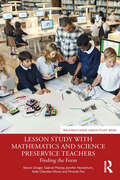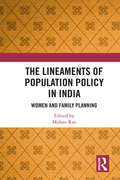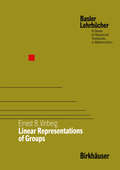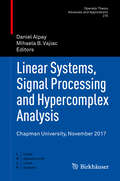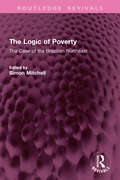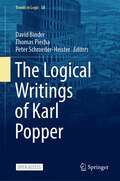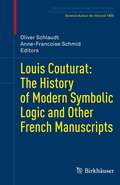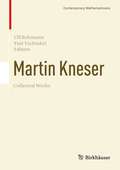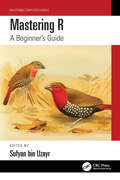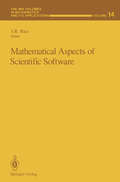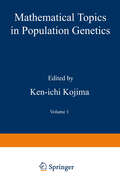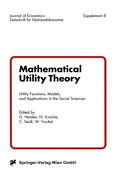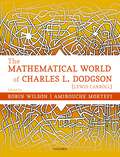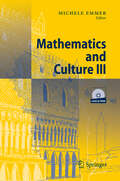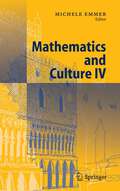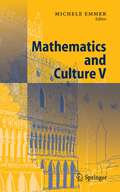- Table View
- List View
Intelligent Systems and Interfaces (International Series in Intelligent Technologies #15)
This volume offers comprehensive coverage of intelligent systems, including fundamental aspects, software-, sensors-, and hardware-related issues. Moreover, the contributors to this volume provide, beyond a systematic overview of intelligent interfaces and systems, deep, practical knowledge in building and using intelligent systems in various applications. Special emphasis is placed on specific aspects and requirements in applications.
IUTAM Symposium on 150 Years of Vortex Dynamics: Proceedings of the IUTAM Symposium “150 Years of Vortex Dynamics” held at the Technical University of Denmark, October 12-16, 2008 (IUTAM Bookseries #20)
In 1858 Hermann von Helmholtz published a paper that today is recognized as the foundation of vortex dynamics. To celebrate the sesquicentennial of Helmholtz’s paper, IUTAM sponsored a symposium that was held at the technical university of Denmark in October 2008. The papers presented at the symposium gave a good overview of where the field of vortex dynamics stands today. This volume contains almost all of the papers presented as lectures at the symposium, and also a few of the poster papers. In this volume the reader will find up-to-date, state-of-theart papers on Point vortices, vortex sheets, vortex filaments, vortex rings, vortex patches, vortex streets, the vortex dynamics of swimming and flying, vortex knots, vortices in turbulent flows, vortices in computational fluid dynamics, the topology of vortex wakes, stability of vortex configurations, vortices on a sphere, geophysical vortices, cosmic vortices and much more.
Jacobi's Lectures on Dynamics: Delivered at the University of Konigsberg in the Winter Semester 1842-1843 and According to the Notes Prepared by C. W. Brockardt (Texts and Readings in Mathematics)
The name of C. G. J. Jacobi is familiar to every student of mathematics, thanks to the Jacobion determinant, the Hamilton-Jacobi equations in dynamics, and the Jacobi identity for vector fields. Best known for his contributions to the theory of elliptic and abelian functions, Jacobi is also known for his innovative teaching methods and for running the first research seminar in pure mathematics. A record of his lectures on Dynamics given in 1842-43 at Konigsberg, edited by A. Clebsch, has been available in the original German. This is an English translation. It is not just a historical document; the modern reader can learn much about the subject directly from one of its great masters.
Joachim Lambek: The Interplay of Mathematics, Logic, and Linguistics (Outstanding Contributions to Logic #20)
This book is dedicated to the life and work of the mathematician Joachim Lambek (1922–2014). The editors gather together noted experts to discuss the state of the art of various of Lambek’s works in logic, category theory, and linguistics and to celebrate his contributions to those areas over the course of his multifaceted career. After early work in combinatorics and elementary number theory, Lambek became a distinguished algebraist (notably in ring theory). In the 1960s, he began to work in category theory, categorical algebra, logic, proof theory, and foundations of computability. In a parallel development, beginning in the late 1950s and for the rest of his career, Lambek also worked extensively in mathematical linguistics and computational approaches to natural languages. He and his collaborators perfected production and type grammars for numerous natural languages. Lambek grammars form an early noncommutative precursor to Girard’s linear logic. In a surprising development (2000), he introduced a novel and deeper algebraic framework (which he called pregroup grammars) for analyzing natural language, along with algebraic, higher category, and proof-theoretic semantics. This book is of interest to mathematicians, logicians, linguists, and computer scientists.
Kooperation und Innovation für eine nachhaltige Stadtentwicklung: Forschung mit innovativen Kommunen
Die Autoren stellen die Ergebnisse des Projekts IER-SEK zusammenfassend vor. IER-SEK ist das Instrument zur Entscheidungsunterstützung für Großvermieter zur Realisierung von Stadtentwicklungskonzepten und wurde im Rahmen der BMBF-Initiative Kommunen innovativ gefördert. Das Buch gibt aber auch einen Ausblick auf weitere Themen, welche die nachhaltige Stadtentwicklung beeinflussen, dazu gehören Stadtentwicklung und Mensch sowie Technologie und Energie.Die Herausgeber:M.Sc. Tim Neumann ist wissenschaftlicher Mitarbeiter an der Westsächsischen Hochschule Zwickau. Dipl.-Ing. Uwe Ziesler arbeitet in der Stabsstelle Stadtentwicklung der Stadt Zwickau. Prof. Dr. rer. pol. habil. Dr.-Ing. Tobias Teich ist Professor für Vernetzte Systeme in der Betriebswirtschaft an der Westsächsischen Hochschule Zwickau.
Kurt Gödel: The Princeton Lectures on Intuitionism (Sources and Studies in the History of Mathematics and Physical Sciences)
Paris of the year 1900 left two landmarks: the Tour Eiffel, and David Hilbert's celebrated list of twenty-four mathematical problems presented at a conference opening the new century. Kurt Gödel, a logical icon of that time, showed Hilbert's ideal of complete axiomatization of mathematics to be unattainable. The result, of 1931, is called Gödel's incompleteness theorem. Gödel then went on to attack Hilbert's first and second Paris problems, namely Cantor's continuum problem about the type of infinity of the real numbers, and the freedom from contradiction of the theory of real numbers. By 1963, it became clear that Hilbert's first question could not be answered by any known means, half of the credit of this seeming faux pas going to Gödel. The second is a problem still wide open. Gödel worked on it for years, with no definitive results; The best he could offer was a start with the arithmetic of the entire numbers. This book, Gödel's lectures at the famous Princeton Institute for Advanced Study in 1941, shows how far he had come with Hilbert's second problem, namely to a theory of computable functionals of finite type and a proof of the consistency of ordinary arithmetic. It offers indispensable reading for logicians, mathematicians, and computer scientists interested in foundational questions. It will form a basis for further investigations into Gödel's vast Nachlass of unpublished notes on how to extend the results of his lectures to the theory of real numbers. The book also gives insights into the conceptual and formal work that is needed for the solution of profound scientific questions, by one of the central figures of 20th century science and philosophy.
Kurt Gödel: Results on Foundations (Sources and Studies in the History of Mathematics and Physical Sciences)
Kurt Gödel (1906-1978) gained world-wide fame by his incompleteness theorem of 1931. Later, he set as his aim to solve what are known as Hilbert's first and second problems, namely Cantor's continuum hypothesis about the cardinality of real numbers, and secondly the consistency of the theory of real numbers and functions. By 1940, he was halfway through the first problem, in what was his last published result in logic and foundations. His intense attempts thereafter at solving these two problems have remained behind the veil of a forgotten German shorthand he used in all of his writing. Results on Foundations is a set of four shorthand notebooks written in 1940-42 that collect results Gödel considered finished. Its main topic is set theory in which Gödel anticipated several decades of development. Secondly, Gödel completed his 1933 program of establishing the connections between intuitionistic and modal logic, by methods and results that today are at the same time new and 80 years old.The present edition of Gödel's four notebooks encompasses the 368 numbered pages and 126 numbered theorems of the Results on Foundations, together with a list of 74 problems on set theory Gödel prepared in 1946, and a list of an unknown date titled "The grand program of my research in ca. hundred questions.''
Learning and Doing Mathematics
Based on a unit of the Open University foundation course in mathematics, this book is not intended to teach any new mathematics, but to improve the ability to assimilate new ideas and to approach problems in a systematic and constructive way and to gain enjoyment from the learning process itself.
The Legacy of Kurt Schütte
This book on proof theory centers around the legacy of Kurt Schütte and its current impact on the subject. Schütte was the last doctoral student of David Hilbert who was the first to see that proofs can be viewed as structured mathematical objects amenable to investigation by mathematical methods (metamathematics). Schütte inaugurated the important paradigm shift from finite proofs to infinite proofs and developed the mathematical tools for their analysis. Infinitary proof theory flourished in his hands in the 1960s, culminating in the famous bound Γ0 for the limit of predicative mathematics (a fame shared with Feferman). Later his interests shifted to developing infinite proof calculi for impredicative theories. Schütte had a keen interest in advancing ordinal analysis to ever stronger theories and was still working on some of the strongest systems in his eighties. The articles in this volume from leading experts close to his research, show the enduring influence of his work in modern proof theory. They range from eye witness accounts of his scientific life to developments at the current research frontier, including papers by Schütte himself that have never been published before.
Lesson Study with Mathematics and Science Preservice Teachers: Finding the Form (WALS-Routledge Lesson Study Series)
This insightful volume offers an overview of the fundamentals of lesson student practice in US teacher education as well as examples from math and science teacher educators using lesson study in their local contexts. The number of teacher educators using lesson study with preservice teachers is small but growing. This book is aimed at teacher educators who may want to try lesson study in university contexts without the challenge of translating the practice from the K-12 context on their own. In this volume, lesson study is broadly overviewed, attention is given to its constituent steps, and examples of lesson study in preservice contexts are shared. Given the broad array of teacher education program designs, numerous contingencies guide teacher educators in their implementation of lesson study, given their contextual affordances and limitations. The lesson study descriptions and cases in this book will support teacher educators and scholars across subject specialities and geographic lines, as they seek instructional frameworks to advance their pedagogical goals.
The Lineaments of Population Policy in India: Women and Family Planning
India is the first country in the world to have an official programme for family planning that commenced in 1952. It has also seen a strong women’s movement to assert reproductive and contraceptive rights. This book brings to the fore several contestations and negotiations between public policy and the women’s movement in India. The comprehensive volume puts together key documents from archival records and authoritative sources, and traces the contours that have marked and defined the population policy in India as well as rights issues for women. A major intervention in the field, this book will be indispensable for scholars and researchers in public policy, public health, demography, gender studies, social policy, development studies, sociology, social justice, human rights, politics and those interested in the study of modern India.
Linear Representations of Groups (Birkhäuser Advanced Texts Basler Lehrbücher)
This book gives an exposition of the fundamentals of the theory of linear representations of finite and compact groups, as well as elements of the the ory of linear representations of Lie groups. As an application we derive the Laplace spherical functions. The book is based on lectures that I delivered in the framework of the experimental program at the Mathematics-Mechanics Faculty of Moscow State University and at the Faculty of Professional Skill Improvement. My aim has been to give as simple and detailed an account as possible of the problems considered. The book therefore makes no claim to completeness. Also, it can in no way give a representative picture of the modern state of the field under study as does, for example, the monograph of A. A. Kirillov [3]. For a more complete acquaintance with the theory of representations of finite groups we recommend the book of C. W. Curtis and I. Reiner [2], and for the theory of representations of Lie groups, that of M. A. Naimark [6]. Introduction The theory of linear representations of groups is one of the most widely ap plied branches of algebra. Practically every time that groups are encountered, their linear representations play an important role. In the theory of groups itself, linear representations are an irreplaceable source of examples and a tool for investigating groups. In the introduction we discuss some examples and en route we introduce a number of notions of representation theory. O.
Linear Systems, Signal Processing and Hypercomplex Analysis: Chapman University, November 2017 (Operator Theory: Advances and Applications #275)
This volume includes contributions originating from a conference held at Chapman University during November 14-19, 2017. It presents original research by experts in signal processing, linear systems, operator theory, complex and hypercomplex analysis and related topics.
The Logic of Poverty: The Case of the Brazilian Northeast (Routledge Revivals)
First published in 1981, The Logic of Poverty consists of eight essays that share at least one assumption: that Northeast Brazil provides a startling example of inhumane economic development. The contributors have all worked in the area, and know it at first hand. They look at rural structure and the role of the unemployed ‘reserve army’, the state of the sugar industry, the ineffectiveness of the irrigation schemes, the stagnation in the fishing sector, the lack of credit available to peasants and the role of SUDENE, the first development agency in the region. Together they paint a picture of poverty and of the factors that allow it to continue, and they place that poverty in the context of the wider economy of Brazil, relating it to the extraordinary transformation that has been called ‘the Brazilian miracle’. This book will be of interest to students of geography, anthropology, economics and sociology.
The Logical Writings of Karl Popper (Trends in Logic #58)
This open access book is the first ever collection of Karl Popper's writings on deductive logic.Karl R. Popper (1902-1994) was one of the most influential philosophers of the 20th century. His philosophy of science ("falsificationism") and his social and political philosophy ("open society") have been widely discussed way beyond academic philosophy. What is not so well known is that Popper also produced a considerable work on the foundations of deductive logic, most of it published at the end of the 1940s as articles at scattered places. This little-known work deserves to be known better, as it is highly significant for modern proof-theoretic semantics.This collection assembles Popper's published writings on deductive logic in a single volume, together with all reviews of these papers. It also contains a large amount of unpublished material from the Popper Archives, including Popper's correspondence related to deductive logic and manuscripts that were (almost) finished, but did not reach the publication stage. All of these items are critically edited with additional comments by the editors. A general introduction puts Popper's work into the context of current discussions on the foundations of logic. This book should be of interest to logicians, philosophers, and anybody concerned with Popper's work.
Louis Couturat: The History of Modern Symbolic Logic and Other French Manuscripts (Publications des Archives Henri Poincaré Publications of the Henri Poincaré Archives)
This volume features a critical edition of the recently rediscovered manuscripts written by the French philosopher Louis Couturat (1868-1914). It includes the transcriptions of three of his believed to be lost manuscripts: first the “Cours de Caen: 1898-99” on various systems of symbolic logic, second his lecture at the Collège de France “Histoire de la logique formelle moderne", and third his textbook on mathematical logic. The manuscripts document the early reception of mathematical logic in France and provide insights into the first introduction of the French reader to the work of Gottlob Frege and Bertrand Russell. It is the aim of the editors of this volume to contribute to the history of symbolic logic, particularly the history of its dissemination and its teaching in France. At the same time, the volume contributes to an alternative history and conception of philosophy in which semiotics and concrete mathematical practice stand in focus. The book is interesting for students and researchers in the history of philosophy, mathematics, and logic.
Martin Kneser Collected Works (Contemporary Mathematicians)
This volume presents the collection of mathematical articles by Martin Kneser, reprinted in the original language – mostly German –, including one yet unpublished. Moreover, also included is an article by Raman Parimala, discussing Kneser’s work concerning algebraic groups and the Hasse principle, which has been written especially for this volume, as well as an article by Rudolf Scharlau about Kneser’s work on quadratic forms, published elsewhere before. Another commentary article, written by Günter M. Ziegler especially for this volume, describes the astounding influence on the field of combinatorics of what was published as “Aufgabe 360” and its subsequent solution in 1955 resp. 1957 in the “Jahresbericht der Deutschen Mathematiker-Vereinigung”. However, as the titles of the articles show, Kneser’s mathematical interests were much broader, which is beautifully discussed in an obituary by Ulrich Stuhler, included as well in this volume.
Mastering R: A Beginner's Guide (Mastering Computer Science)
R is a statistical computing and graphics programming language that you can use to clean, analyze, and graph data. It is widely used by researchers from various disciplines to estimate and display results and by teachers of statistics and research methods. This book is a detailed guide for beginners to understand R with an explanation of core statistical and research ideas. One of the powerful characteristics of R is that it is open-source, which means that anyone can access the underlying code used to run the program and add their own code for free. It will always be able to perform the latest statistical analyses as soon as anyone thinks of them. R corrects mistakes quickly and transparently and has put together a community of programming and statistical experts that you can turn to for help. Mastering R: A Beginner’s Guide not only explains how to program but also how to use R for visualization and modeling. The fundamental principles of R explained here are helpful to beginner and intermediate users interested in learning this highly technological and diverse language.
Mathematical Aspects of Scientific Software (The IMA Volumes in Mathematics and its Applications #14)
Since scientific software is the fuel that drives today's computers to solve a vast range of problems, huge efforts are being put into the development of new software, systems and algorithms for scientific problem solving. This book explores how scientific software impacts the structure of mathematics, how it creates new subfields, and how new classes of mathematical problems arise. The focus is on five topics where the impact is currently being felt and where important new challenges exist, namely: the new subfield of parallel and geometric computations, the emergence of symbolic computation systems into "general" use, the potential emergence of new, high-level mathematical systems, and the crucial question of how to measure the performance of mathematical problem solving tools.
Mathematical Topics in Population Genetics (Biomathematics #1)
A basic method of analyzing particulate gene systems is the proba bilistic and statistical analyses. Mendel himself could not escape from an application of elementary probability analysis although he might have been unaware of this fact. Even Galtonian geneticists in the late 1800's and the early 1900's pursued problems of heredity by means of mathe matics and mathematical statistics. They failed to find the principles of heredity, but succeeded to establish an interdisciplinary area between mathematics and biology, which we call now Biometrics, Biometry, or Applied Statistics. A monumental work in the field of popUlation genetics was published by the late R. A. Fisher, who analyzed "the correlation among relatives" based on Mendelian gene theory (1918). This theoretical analysis over came "so-called blending inheritance" theory, and the orientation of Galtonian explanations for correlations among relatives for quantitative traits rapidly changed. We must not forget the experimental works of Johanson (1909) and Nilsson-Ehle (1909) which supported Mendelian gene theory. However, a large scale experiment for a test of segregation and linkage of Mendelian genes affecting quantitative traits was, prob ably for the first time, conducted by K. Mather and his associates and Panse in the 1940's.
Mathematical Utility Theory: Utility Functions, Models, and Applications in the Social Sciences (Journal of Economics Zeitschrift für Nationalökonomie Supplementum #8)
This proceedings volume of an international conference which took place in Essen in October 1997 brings together economists, mathematicians, and psychologists. Their contributions represent new research in the field of mathematical utility theory with an emphasis on its applications in the social sciences. Readers of this volume can inform themselves about novel results in mathematical utility theory and their significance for the social sciences. The contributions cover a spectrum of fields from topological methods in utility theory to the application of experimental methods to utility theory.
The Mathematical World of Charles L. Dodgson (Lewis Carroll)
Charles Lutwidge Dodgson is best known for his 'Alice' books, Alice's Adventures in Wonderland and Through the Looking-Glass, written under his pen name of Lewis Carroll. Yet, whilst lauded for his work in children's fiction and his pioneering work in the world of Victorian photography, his everyday job was a lecturer in Mathematics at Christ Church, Oxford University. The Mathematical World of Charles L. Dodgson (Lewis Carroll) explores the academic background behind this complex individual, outlining his mathematical life, describing his writings in geometry, algebra, logic, the theory of voting, and recreational mathematics, before going on to discuss his mathematical legacy. This is the first academic work that collects the research on Dodgson's wide-ranging mathematical achievements into a single practical volume. Much material appears here for the first time, such as Dodgson's personal letters and drawings, as well as the results of recent investigations into the life and work of Dodgson. Complementing this are many illustrations, both historical and explanatory, as well as a full mathematical bibliography of Dodgson's mathematical publications.
Mathematics and Culture III
This work contains the proceedings of the "Mathematics and Culture" conference held in Venice in March 2002. The conference aims to act as a bridge across the various aspects of human knowledge. While keeping mathematics as its core, it is aimed at anyone endowed with cultural curiosity and interests, whether within or (even more so) outside mathematics. This volume therefore covers music, cinema, art, theatre and literature, with topics ranging from Tibet to comics.
Mathematics and Culture IV
Gaudi’s dream which will be reached finalizing the construction of the "Sagrada Familia" in Barcelona, the victory of the Swiss sail boat "Alinghi", which won America’s Cup, films such as " A Beautiful Mind" and "Enigma", the theatrical play based on the life of Galois, the images of the Dutch graphic artist M. C. Escher, crypotography, comics. What all these topics have in common? Mathematics, of course. This book focuses on the important role of mathematics in culture. It shows how very complex links between mathematics and culture can be not only interesting and stimulating but also fun.
Mathematics and Culture V
“I mean the third”cried the old man taking up the geometry book. “Well, young lady…”and he bent over his daughter. The princess gazed with terror into her father's keen eyes. He, on his part, got angry – pushed away his chair, dragged it back with a cl- ter – trying all the while to control himself; then again he would break out and storm, and wish the whole thing to the devil. As ill-luck would have it, to-day again his daughter answered at random and wrongly. “What an idiot!”he exclaimed, flinging down the book. The he rose, walked up and down, came back and stroked his daughter's hair, sat down again, and began his explanation once more. “It does not do, princess, it does not do”, he said, seeing her rise to leave him with VII the book in her hand. “Mathematics is a noble science, and I do not want you to be just like all the silly young ladies one meets. Persevere and you will learn to like the work, and the dullness will be nocked out of your brain. ” These words were spoken by Prince Andrei Bolkonskij, who was talking to Princess Marja Bolokonskaja, his daughter. They are two of the protagonists of Lev Tolstoy’s War and Peace, finished in 1869.
